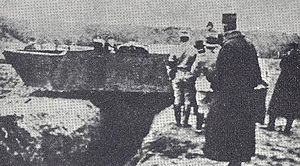The Souain experiment was a French military experiment using a prototype tank, in the former battlefield of Souain, in northeastern France, on 9 December 1915. The experiment has a decisive influence of the French tank program and initiated the design and order of the first French operational tank, the Schneider CA1. The experiment occurred the same month the British Little Willie was being completed.
Background[]
The immobility of the trench warfare characterizing the First World War led to a need for a powerfully armed military engine that would be at the same time protected from enemy fire and could move on the extremely irregular terrain of battlefields. This led to numerous attempts at designing an effective all-terrain armoured vehicle.[1]
Caterpillar experiments[]
In January 1915, the French arms manufacturer Schneider & Co. sent out its chief designer, Eugène Brillié, to investigate tracked tractors from the American Holt Company, at that time participating in a test programme in England, for a project of mechanical wire-cutting machines of the Breton-Pretot type. On his return Brillié, who had earlier been involved in designing armoured cars for Spain, convinced the company management to initiate studies on the development of a Tracteur blindé et armé (armoured and armed tractor), based on the Baby Holt chassis, two of which were ordered.
Experiments on the Holt caterpillar tracks started in May 1915 at the Schneider plant with a 75 hp wheel-directed model and the 45 hp integral caterpillar Baby Holt, showing the superiority of the latter.[2] On 16 June, new experiments followed in front of the President of the French Republic, and on 10 September for Commander Ferrus, an officer who had been involved in the study (and ultimate abandonment) of the Levavasseur tank project in 1908.[3]
Finally, a Baby Holt caterpillar was demonstrated at Souain on 9 December 1915, to the French Army, with the participation of commandant Ferrus, lieutenant Charles Fouché, Colonel Estienne]and General Philippe Pétain.[4][5]
Souain was a former battlefield with rough terrain and trenches, recently conquered over the Germans, and offered perfect conditions to test the qualities of the new tank prototype.
The results of the Baby Holt caterpillar were excellent, displaying remarkable mobility in the difficult terrain of Souain. The length of the Baby Holt however appeared to be too short to bridge German trenches, justifying the development of longer caterpillar tracks for the French tank project.[6] The Souain prototype could effectively bridge shell holes and trenches up to 1 meter in width, with a maximum limit of 1.20 meters, but required some sustainment to bridge wider gaps, rendering it unsatisfactory as such.[7] According to the official report "the machine can only cross through a cut-up terrain if some basic trench sustainment is prepared"[8]
See also[]
Notes[]
- ↑ Gougaud, p.102
- ↑ Gougaud, p.102-111
- ↑ Gougaud, p.215
- ↑ Gougaud, p.111
- ↑ Armoured fighting vehicles of the world Duncan Crow 1970 p.68 "On December 9, 1915, the Baby Holt, modified with a mock-up armoured driving position ... was demonstrated on a cross-country course at Souain"
- ↑ Landships
- ↑ Gougaud, p.111
- ↑ Original French: "La machine ne peut passer à travers un terrain coupé qu'autant qu'on lui prépare très sommairement des passages de tranchées", excerpt of the official report in Gougaud, p.111
References[]
- lain Gougaud L'Aube de la Gloire, Les Autos-Mitrailleuses et les Chars Français pendant la Grande Guerre, 1987, Musée des Blindés, ISBN 2-904255-02-8
| |||||||||||||||||||||||||||||
The original article can be found at Souain experiment and the edit history here.
